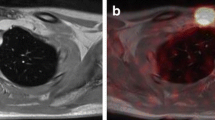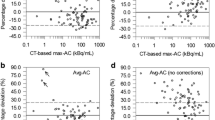Abstract
Purpose
This study compares intrinsically coregistered 124I positron emission tomography (PET) and CT (PET/CT) and software coregistered 124I PET and MRI (PET/MRI) images for the diagnosis and dosimetry of thyroid remnant tissues and lymph node metastases in patients with differentiated thyroid carcinoma (DTC).
Methods
After thyroidectomy, 33 high-risk DTC patients (stage III or higher) received 124I PET/CT dosimetry prior to radioiodine therapy to estimate the absorbed dose to lesions and subsequently underwent a contrast-enhanced MRI examination of the neck. Images were evaluated by two experienced nuclear medicine physicians and two radiologists to identify the lesions and to categorize their presumable provenience, i.e. thyroid remnant tissue (TT), lymph node metastasis (LN) and inconclusive tissue. The categorization and dosimetry of lesions was initially performed with PET images alone (PET only). Subsequently lesions were reassessed including the CT and MRI data.
Results
The analyses were performed on a patient and on a lesion basis. Patient-based analyses showed that 26 of 33 (79%) patients had at least one lesion categorized as TT on PET only. Of these patients, 11 (42%) and 16 (62%) had a morphological correlate on CT and MRI, respectively, in at least one TT PET lesion. Twelve patients (36%) had at least one lesion classified as LN on PET only. Nine (75%) of these patients had a morphological correlate on both CT and MRI in at least one LN PET lesion. Ten patients (30%) showed at least one lesion on PET only classified as inconclusive. The classification was changed to a clear classification in two patients (two LN) by CT and in four (two TT, two LN) patients by MRI. Lesion-based analyses (n = 105 PET positive lesions) resulted in categorization as TT in 61 cases (58%), 16 (26%) of which had a morphological correlate on CT and 33 (54%) on MRI. A total of 29 lesions (27%) were classified as LN on PET, 18 (62%) of which had a morphological correlate on CT and 24 (83%) on MRI. In 16 lesions (15%) PET alone allowed no definite categorization. Categorization was achieved with the aid of CT and MRI, respectively, in five (one TT, four LN) and in six (two TT, four LN) lesions. In direct comparison, 23 lesions were not discernible on CT but clearly visible on MRI, 15 of which were smaller than 10 mm and about two thirds were classified as TT. Redoing dosimetry based on the volume information from MRI for these small lesions would have changed the initial therapy regime in five patients. These patients would have received 131I therapy with standardized activities of 3.7 GBq or 7.4 GBq instead of activities higher than 10 GBq and would have benefited from reduced radiation exposure.
Conclusion
PET/MRI is superior to PET/CT in terms of tracing back a PET focus to a morphological correlate. For this reason PET/MRI enhances diagnostic certainty for lesions < 10 mm and improves pretherapeutic lesion dosimetry in DTC.






Similar content being viewed by others
References
Luster M, Clarke SE, Dietlein M, Lassmann M, Lind P, Oyen WJ, et al. Guidelines for radioiodine therapy of differentiated thyroid cancer. Eur J Nucl Med Mol Imaging 2008;35:1941–59.
American Thyroid Association (ATA) Guidelines Taskforce on Thyroid Nodules and Differentiated Thyroid Cancer, Cooper DS, Doherty GM, Haugen BR, Kloos RT, Lee SL, et al. Revised American Thyroid Association management guidelines for patients with thyroid nodules and differentiated thyroid cancer. Thyroid 2009;19:1167–214.
Jentzen W, Freudenberg L, Eising EG, Sonnenschein W, Knust J, Bockisch A. Optimized 124I PET dosimetry protocol of radioiodine therapy of differentiated thyroid cancer. J Nucl Med 2008;49:1017–23.
Sgouros G, Kolbert KS, Sheikh A, Pentlow KS, Mun EF, Barth A, et al. Patient-specific dosimetry for 131I thyroid cancer therapy using 124I PET and 3-dimensional-internal dosimetry (3D-ID) software. J Nucl Med 2004;45:1366–72.
Tezelman S, Giles Y, Tunca F, Gok K, Poyanli A, Salmaslioglu A, et al. Diagnostic value of dynamic contrast medium enhanced magnetic resonance imaging in preoperative detection of thyroid carcinoma. Arch Surg 2007;142(11):1036–41.
Erdi YE, Macapinlac H, Larson SM, Erdi AK, Yeung H, Furhang EE, et al. Radiation dose assessment for I-131 therapy of thyroid cancer using I-124 PET imaging. Clin Positron Imaging 1999;2:41–6.
Eschmann SM, Reischl G, Bilger K, Kupferschläger J, Thelen MH, Dohmen BM, et al. Evaluation of dosimetry of radioiodine therapy in benign and malignant thyroid disorders by means of iodine-124 and PET. Eur J Nucl Med Mol Imaging 2002;29:760–7.
Freudenberg L, Jentzen W, Görges R, Petrich T, Marlowe RJ, Knust J, et al. 124I-PET dosimetry in advance differentiated cancer: therapeutic impact. Nuklearmedizin 2007;46:121–8.
Marinelli LD, Quimby EH, Hine GJ. Dosage determination with radioactive isotopes; practical considerations in therapy and protection. Am J Roentgenol Radium Ther 1948;59:260–81.
Jentzen W, Freudenberg LS, Heinze M, Eising EG, Brandau W, Bockisch A. Segmentation of PET volumes by iterative image thresholding. J Nucl Med 2007;48:108–14.
Stahl RA, Freudenberg L, Bockisch A, Jentzen W. A novel view on dosimetry-related radionuclide therapy: presentation of a calculatory model and its implementation for radioiodine therapy of metastasized differentiated thyroid carcinoma. Eur J Nucl Med Mol Imaging 2009;36:1147–55.
Jentzen W, Freudenberg LS, Bockisch A. Quantitative imaging of 124I with PET/CT in pretherapy lesion dosimetry. Effects impairing image quantification and their corrections. Q J Nucl Med Mol Imaging 2011;55:21–43.
DeNardo GL, Shen S, DeNardo SJ, Liao SQ, Lamborn KR, DeNardo DA, et al. Quantification of iodine-131 in tumors using a threshold based on image contrast. Eur J Nucl Med 1998;25:497–502.
Seiboth L, Van Nostrand D, Wartofsky L, Ousman Y, Jonklaas J, Butler C, et al. Utility of PET/neck MRI digital fusion images in the management of recurrent or persistent thyroid cancer. Thyroid 2008;18(2):103–11.
Jentzen W. Experimental investigation of factors affecting the absolute recovery coefficients in iodine-124 PET lesion imaging. Phys Med Biol 2010;55:2365–98.
Benua R, Cicale N, Sonenberg M, Rawson RW. The relation of radioiodine dosimetry to results and complications in the treatment of metastatic thyroid cancer. Am J Roentgenol Radium Ther Nucl Med 1962;87:171–82.
Frey P, Townsend D, Flattet A, De Gautard R, Widgren S, Jeavons A, et al. Tomographic imaging of the human thyroid using 124I. J Clin Endocrinol Metab 1986;63:918–27.
Hickeson M, Yun M, Matthies A, Zhuang H, Adam L-E, Lacorte L, et al. Use of a corrected standardized uptake value based on the lesion size on CT permits accurate characterization of lung nodules on FDG-PET. Eur J Nucl Med Mol Imaging 2002;29:1639–47.
Kaplan SL, Mandel SJ, Muller R, Baloch ZW, Thaler ER, Loevner LA. The role of MR imaging in detecting nodal disease in thyroidectomy patients with rising thyroglobulin levels. AJNR Am J Neuroradiol 2009;30(3):608–12.
Maxon HR, Englaro EE, Thomas SR, Hertzberg VS, Hinnefeld JD, Chen LS, et al. Radioiodine-131 therapy for well-differentiated thyroid cancer—a quantitative radiation dosimetric approach: outcome and validation in 85 patients. J Nucl Med 1992;33:1132–16.
Furhang EE, Larson SM, Buranapong P, Humm JL. Thyroid cancer dosimetry using clearance fitting. J Nucl Med 1999;40(1):131–6.
Apaydin M, Varer M, Sarsilmaz A, Coskun G, Yildiz S, Akin H. Ectopic thyroid tissue in the neck region. Nuklearmedizin 2009;48:N21–3.
Conflicts of interest
None.
Author information
Authors and Affiliations
Corresponding author
Rights and permissions
About this article
Cite this article
Nagarajah, J., Jentzen, W., Hartung, V. et al. Diagnosis and dosimetry in differentiated thyroid carcinoma using 124I PET: comparison of PET/MRI vs PET/CT of the neck. Eur J Nucl Med Mol Imaging 38, 1862–1868 (2011). https://doi.org/10.1007/s00259-011-1866-1
Received:
Accepted:
Published:
Issue Date:
DOI: https://doi.org/10.1007/s00259-011-1866-1




